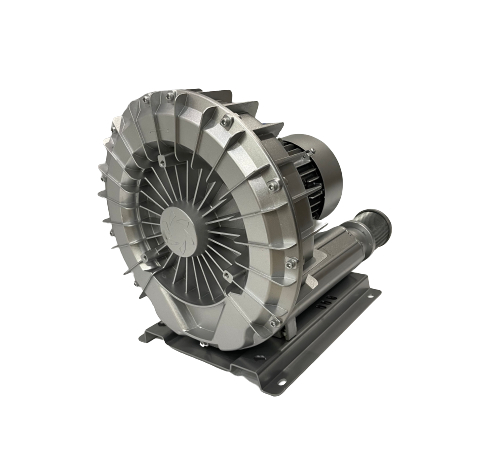A blower is a device used in systems to create partial or complete vacuum by removing air or gas from a tank. Air is drawn in with a gradual decrease in pressure in the enclosed space. The extracted gas molecules are then discharged into the ambient air or another tank. Vacuum pumps are used in various sectors such as laboratories, the medical industry, food packaging, and the chemical industry.

Generally, blowers, also known as vacuum pumps, provide the transfer of air at high flow rates and low pressure in environments subjected to emissions. They are also installation equipment capable of rotating the fan with the help of the motor power they receive from the engine.
Choosing the right blower requires considering several factors. First and foremost, your choice needs to be compatible with the desired application. This allows you to determine the necessary technology, lubrication, chemical resistance, vacuum level, and required flow rate. The primary factor that should guide your blower selection is the desired quality and level of vacuum. There are several types of blowers:
The difference between these three lies in the rarity of the number of molecules obtained, measured by the pressure of the residual gases. The lower the pressure, the fewer molecules per cm³ there are. As a result, the vacuum quality is higher.
The widespread use of vacuum pumps signifies a technology that assists production processes. They are used across all industrial sectors, including environment, chemistry, healthcare, food processing, plastics, packaging, glass, metallurgy, ceramics, printing, and many more.
Use in Air Conditioning Systems: Vacuum pumps play a crucial role in cooling and air conditioning. They are used in the automotive sector to remove moisture from the intake air, ensuring the proper functioning of the air conditioning system.
Use of Blowers in the Food Industry: In the food sector, blowers are predominantly used in the food industry and bottling plants. A vacuum pump is always present in food processing. They are also used in specific applications such as tobacco humidification, vegetable cleaning, ham drying, potato aeration, salmon processing, and sausage machines. Other uses of food vacuum pumps include milk processing, coffee roasting, and sugar production.
Vacuum pumps are a significant part of food packaging. They are used in filling and sealing machines, food packaging and processing, and the manufacturing of PET containers. Vacuum pumps also play an important role in the non-food sector.
Use in Environmental and Chemical Sectors: Blowers, which have a very wide range of applications, are used in many areas. For example, they are frequently used for oxygen enrichment or wastewater treatment, waste disposal from storage areas and solar collectors. This technology also contributes significantly to compressors in biogas plants.
In the chemical industry, the use of blowers is common for the transfer of gases, chemicals, mixtures, and other types of materials, as well as for processing raw materials for industrial-scale production.
Use of Blowers in Various Sectors: Vacuum pumps are found in plastic, rubber, and resin processing applications. Some examples include calibration, contactless turning of plastic films, dryers, vacuum processes, composite material production, and expanded polystyrene foam production.
In the printing and paper industry, central air and vacuum systems are essential for various stages of cardboard production to produce the final product. Vacuum pressure and vacuum technology are crucial in various stages of printing and paper production.
In ceramics and marble production, blowers are used for degassing, to remove gas. In ceramic production, seamless production is achieved with the help of a vacuum pump. These pumps are also used post-production or in the assembly of products and materials. In the wood sector, vacuum technology is used for preservation, vacuum drying, and vacuum pressing processes.
A vacuum pump can be used in various areas of analytical applications: lasers, leak detection, freeze-drying, mass spectrometry, chromatography, microscopy, room simulators, vacuum distillation, gel drying, centrifuges, and laboratory autoclaves.
Fans are mechanical devices used to circulate air. Based on this, a fan is separated from a blower, which circulates the air in a room and focuses on a specific or certain area. Although both fans and blowers are similar in terms of air flow, they are technically different. The main difference between a fan and a blower is the air flow.
Generally, a fan is an electric device that moves air. A blower, on the other hand, is a mechanical device consisting of a fan that takes air from the fan and directs it to a specific place or point. A fan circulates air throughout the entire room or a large area, while a blower is positioned in a specific direction or point at a certain pressure.
In general, it is very common to use fans and vacuum pumps to provide air for ventilation in industrial processes. These are used for cooling purposes in industries. Both are widely used in other electrical devices such as air conditioners and microwave ovens.
Although both are used according to the pressure needed to produce air, each is used accordingly. Generally, devices used as blowers move volumes of gas at medium pressure. Fans can move large volumes of gas at low pressure.
Definition:
Many fans are operated by electric motors, but other sources such as hydraulic motors or internal combustion engines can also be used. In this regard, both devices differ based on their operating characteristics. Considering this, the main differences between a fan and a blower are as follows: